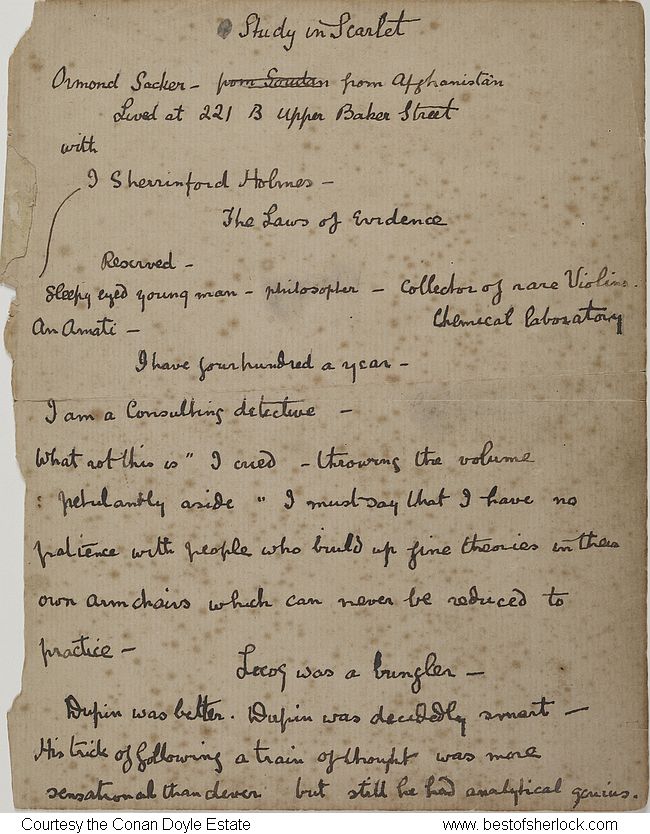| Home | Manuscripts | Top-10 Lists | e-World | Site Index |
|
The Best of Sherlock Holmes |
www.bestofsherlock.com/ref/museum-london-origins-holmes.htm
Origins of Sherlock Holmes Revealed:
The Museum of London 2014 Exhibition
By Randall Stock, October 17, 2014
For the first time ever, Sherlockians have a chance to see the earliest notes about Sherlock Holmes alongside the manuscript of the detective story that helped inspire Conan Doyle's creation of the world's greatest detective.
Notes on display at the Museum of London reveal that Conan Doyle originally named his detective as "Sherrinford Holmes" and his partner as "Ormond Sacker." They also show a connection to Edgar Allan Poe's first detective story.

Lent by the heirs of Anna Conan Doyle
Some Comparisons for A Study in Scarlet
Notes: Sherrinford Holmes & Ormond Sacker from Afghanistan
Published: Sherlock Holmes & Dr. John H. Watson from Afghanistan
Notes: What rot this is" I cried
Published: "What ineffable twaddle!" I cried
Notes: Dupin was better. Dupin was decidedly smart – His trick of following of following a train of thought was more sensational than clever but still he had analytical genius.
Published: Dupin was a very inferior fellow. That trick of his of breaking in on his friends' thoughts with an apropos remark after a quarter of an hour's silence is really very showy and superficial. He had some analytical genius, no doubt;…
Notes: Lecoq was a bungler
Published: Lecoq was a miserable bungler
Edgar Allan Poe and Sherlock Holmes
The Museum of London is displaying the manuscript of Poe's "The Murders in the Rue Morgue," an 1841 story that Conan Doyle listed as one of his favorites. As shown above, he mentions the detective from that tale, Dupin, in his notes for A Study in Scarlet.
In those notes he describes Dupin as "better" and "decidedly smart." However, in his final published version of A Study in Scarlet, he changes that to say "Dupin was a very inferior fellow." Conan Doyle praised Dupin in 1912 and explained that a writer does not always share the opinions expressed by his characters. In fact, in 1892 the author called Dupin "the best detective in fiction," and in 1907 wrote that a detective story author's "main art must trace back to those admirable stories of Monsieur Dupin."
The 2014 exhibition is the first public display of "The Murders in the Rue Morgue" manuscript in the UK, and it is the first time it has been paired with the earliest notes about Sherlock Holmes.
The page of notes shown above, sometimes described as the "Sherlock Holmes birth certificate," is the most frequently reproduced Holmes manuscript material, with more than 20 appearances listed for the Study in Scarlet facsimile #111. While the original leaf was shown in the 1951 Festival of Britain Holmes Exhibition (item 12), it's been nearly impossible to see in the last 50 years.
Extracts from A Study in Scarlet (as published)
The following extracts provide more context of how Conan Doyle went from his early notes shown above to the final text of this story.
"What ineffable twaddle!" I cried, slapping the magazine down on the table; "I never read such rubbish in my life."
"What is it?" asked Sherlock Holmes.
"Why, this article," I said, pointing at it with my egg-spoon as I sat down to my breakfast. "I see that you have read it since you have marked it. I don't deny that it is smartly written. It irritates me, though. It is evidently the theory of some armchair lounger who evolves all these neat little paradoxes in the seclusion of his own study. It is not practical. I should like to see him clapped down in a third-class carriage on the Underground, and asked to give the trades of all his fellow-travelers. I would lay a thousand to one against him."
…
Sherlock Holmes rose and lit his pipe. "No doubt you think that you are complimenting me in comparing me to Dupin," he observed. "Now, in my opinion, Dupin was a very inferior fellow. That trick of his of breaking in on his friends' thoughts with an apropos remark after a quarter of an hour's silence is really very showy and superficial. He had some analytical genius, no doubt; but he was by no means such a phenomenon as Poe appeared to imagine."
"Have you read Gaboriau's works?" I asked. "Does Lecoq come up to your idea of a detective?"
Sherlock Holmes sniffed sardonically. "Lecoq was a miserable bungler," he said, in an angry voice; …
Exhibition Summary
The Museum of London:
Sherlock Holmes: The Man Who Never Lived and Will Never Die
http://www.museumoflondon.org.uk/Sherlock
Internet Archive of Museum pages
17 October 2014 – 12 April 2015
The manuscript of "The Murders in the Rue Morgue" and the notes for A Study in Scarlet appear in the "Genesis of Sherlock Holmes" section of the exhibition.
For more details, including links to recommended news reports and videos, see my main exhibition information page.
See also Holmes manuscripts at the Museum of London and Sidney Paget artwork at the Museum of London.
Acknowledgements
My congratulations and thanks to Alex Werner and Andrew Scott at the Museum of London for putting on this great exhibition and providing details about it. Also thanks to Jon Lellenberg for information about the notes and manuscript.
Related Pages
Holmes manuscripts at the Museum of London
Census of original Sherlock Holmes Manuscripts
Census of original Sidney Paget Drawings
Other Conan Doyle rarities like Beeton's Christmas Annual 1887.
Lists of each year's best Sherlock Holmes books & DVDs, the most famous Sherlock Holmes quotes, and more Top 10 Lists.
Return to Manuscripts Home page and Introduction
Vers. 2.1ax-RN Original work
Copyright ©2014
Randall Stock. All Rights Reserved.